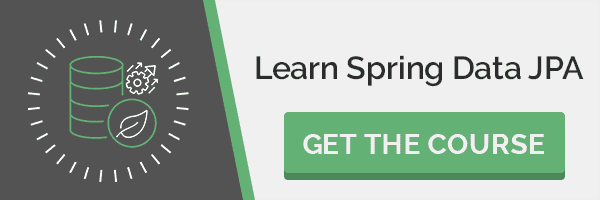1. Overview
Apache Kafka is a distributed and fault-tolerant stream processing system.
In this tutorial, we’ll cover Spring support for Kafka and its abstraction level over native Kafka Java client APIs.
Spring Kafka brings the simple and typical Spring template programming model with a KafkaTemplate and Message-driven POJOs via @KafkaListener annotation.
2. What Is a Listener Container in Spring for Apache Kafka?
The Spring Framework implements the Inversion of Control (IoC) principle via Dependency injection (DI). Objects define their dependencies directly, and an IoC container injects them when creating a bean. Beans are objects instantiated, assembled, and managed by a Spring IoC container. In other words, a container is an application context responsible for instantiating, configuring, and assembling the beans.
In the context of Apache Kafka, a listener container is a container that contains a consumer, or listener, of Kafka messages. Further, Spring for Apache Kafka uses a container factory to create message listener containers. We use the @KafkaListener annotation to designate a bean method as a message listener for a listener container. Accordingly, a container factory creates listener containers for bean methods annotated with @KafkaListener. The Spring for Apache Kafka framework provides interfaces and classes to manage the instantiation of listener containers:
- org.springframework.kafka.listener.MessageListenerContainer – An abstraction used to instantiate Kafka message listener containers
- org.springframework.kafka.listener.KafkaMessageListenerContainer – An implementation class used to create a single-threaded message listener container
- org.springframework.kafka.listener.ConcurrentMessageListenerContainer – An implementation class used to create one or more KafkaMessageListenerContainers based on concurrency
- org.springframework.kafka.config.KafkaListenerContainerFactory – An abstract factory for MessageListenerContainers
- org.springframework.kafka.config.ConcurrentKafkaListenerContainerFactory – An implementation class used to create a ConcurrentMessageListenerContainer
Learn how to process stream data with Flink and Kafka
Have a look at a practical example using Kafka connectors.
3. Installation and Setup
To download and install Kafka, please refer to the official guide here.
We also need to add the spring-kafka dependency to our pom.xml:
<dependency>
<groupId>org.springframework.kafka</groupId>
<artifactId>spring-kafka</artifactId>
<version>3.3.1</version>
</dependency>
And configure the spring-boot-maven-plugin as follows:
<plugin>
<groupId>org.springframework.boot</groupId>
<artifactId>spring-boot-maven-plugin</artifactId>
<configuration>
<mainClass>com.baeldung.spring.kafka.KafkaApplication</mainClass>
</configuration>
</plugin>
We can find the latest version of this artifact here.
Our example application will be a Spring Boot application.
We assume that the server has started using the default configuration and that we have not changed any server ports.
4. Configuring Topics
Previously, we ran command-line tools to create Kafka “topics”:
$ bin/kafka-topics.sh --create
--zookeeper localhost:2181
--replication-factor 1 --partitions 1
--topic mytopic
But with the introduction of AdminClient in Kafka, we can now create topics programmatically.
We need to add the KafkaAdmin Spring bean, which will automatically add topics for all beans of type NewTopic:
@Configuration
public class KafkaTopicConfig {
@Value(value = "${spring.kafka.bootstrap-servers}")
private String bootstrapAddress;
@Bean
public KafkaAdmin kafkaAdmin() {
Map<String, Object> configs = new HashMap<>();
configs.put(AdminClientConfig.BOOTSTRAP_SERVERS_CONFIG, bootstrapAddress);
return new KafkaAdmin(configs);
}
@Bean
public NewTopic topic1() {
return new NewTopic("baeldung", 1, (short) 1);
}
}
5. Producing Messages
To create messages, we first need to configure a ProducerFactory. This sets the strategy for creating Kafka Producer instances.
Then, we need a KafkaTemplate, which wraps a Producer instance and provides convenience methods for sending messages to Kafka topics.
Producer instances are thread-safe. So, using a single instance throughout an application context will give higher performance. Consequently, KakfaTemplate instances are also thread-safe, and the use of one instance is recommended.
5.1. Producer Configuration
@Configuration
public class KafkaProducerConfig {
@Bean
public ProducerFactory<String, String> producerFactory() {
Map<String, Object> configProps = new HashMap<>();
configProps.put(
ProducerConfig.BOOTSTRAP_SERVERS_CONFIG,
bootstrapAddress);
configProps.put(
ProducerConfig.KEY_SERIALIZER_CLASS_CONFIG,
StringSerializer.class);
configProps.put(
ProducerConfig.VALUE_SERIALIZER_CLASS_CONFIG,
StringSerializer.class);
return new DefaultKafkaProducerFactory<>(configProps);
}
@Bean
public KafkaTemplate<String, String> kafkaTemplate() {
return new KafkaTemplate<>(producerFactory());
}
}
5.2. Publishing Messages
We can send messages using the KafkaTemplate class:
@Autowired
private KafkaTemplate<String, String> kafkaTemplate;
public void sendMessage(String msg) {
kafkaTemplate.send(topicName, msg);
}
The send API returns a CompletableFuture object. If we want to block the sending thread and get the result about the sent message, we can call the get API of the CompletableFuture object. The thread will wait for the result, but it will slow down the producer.
Kafka is a fast-stream processing platform. Therefore, it’s better to handle the results asynchronously so that the subsequent messages do not wait for the result of the previous message.
We can do this through a callback:
public void sendMessage(String message) {
CompletableFuture<SendResult<String, String>> future = kafkaTemplate.send(topicName, message);
future.whenComplete((result, ex) -> {
if (ex == null) {
System.out.println("Sent message=[" + message +
"] with offset=[" + result.getRecordMetadata().offset() + "]");
} else {
System.out.println("Unable to send message=[" +
message + "] due to : " + ex.getMessage());
}
});
}
6. Consuming Messages
6.1. Consumer Configuration
To consume messages, we need to configure a ConsumerFactory and a KafkaListenerContainerFactory. Once these beans are available in the Spring Bean factory, POJO-based consumers can be configured using @KafkaListener annotation.
@EnableKafka annotation is required on the configuration class to enable the detection of @KafkaListener annotation on spring-managed beans:
@EnableKafka
@Configuration
public class KafkaConsumerConfig {
@Bean
public ConsumerFactory<String, String> consumerFactory() {
Map<String, Object> props = new HashMap<>();
props.put(
ConsumerConfig.BOOTSTRAP_SERVERS_CONFIG,
bootstrapAddress);
props.put(
ConsumerConfig.GROUP_ID_CONFIG,
groupId);
props.put(
ConsumerConfig.KEY_DESERIALIZER_CLASS_CONFIG,
StringDeserializer.class);
props.put(
ConsumerConfig.VALUE_DESERIALIZER_CLASS_CONFIG,
StringDeserializer.class);
return new DefaultKafkaConsumerFactory<>(props);
}
@Bean
public ConcurrentKafkaListenerContainerFactory<String, String>
kafkaListenerContainerFactory() {
ConcurrentKafkaListenerContainerFactory<String, String> factory =
new ConcurrentKafkaListenerContainerFactory<>();
factory.setConsumerFactory(consumerFactory());
return factory;
}
}
6.2. Consuming Messages
Let’s configure a POJO-based listener, also called consumer, using the @KafkaListener annotation:
@KafkaListener(topics = "topicName", groupId = "foo")
public void listenGroupFoo(String message) {
System.out.println("Received Message in group foo: " + message);
}
We can implement multiple listeners for a topic, each with a different group ID. Furthermore, one consumer can listen for messages from various topics:
@KafkaListener(topics = "topic1, topic2", groupId = "foo")
Spring also supports retrieval of one or more message headers using the @Header annotation in the listener:
@KafkaListener(topics = "topicName")
public void listenWithHeaders(
@Payload String message,
@Header(KafkaHeaders.RECEIVED_PARTITION_ID) int partition) {
System.out.println(
"Received Message: " + message"
+ "from partition: " + partition);
}
6.3. Consuming Messages from a Specific Partition
Notice that we created the topic baeldung with only one partition.
For a topic with multiple partitions, however, a @KafkaListener can explicitly subscribe to a particular partition of a topic with an initial offset:
@KafkaListener(
topicPartitions = @TopicPartition(topic = "topicName",
partitionOffsets = {
@PartitionOffset(partition = "0", initialOffset = "0"),
@PartitionOffset(partition = "3", initialOffset = "0")}),
containerFactory = "partitionsKafkaListenerContainerFactory")
public void listenToPartition(
@Payload String message,
@Header(KafkaHeaders.RECEIVED_PARTITION_ID) int partition) {
System.out.println(
"Received Message: " + message"
+ "from partition: " + partition);
}
Since the initialOffset has been set to 0 in this listener, all the previously consumed messages from partitions 0 and 3 will be re-consumed every time this listener is initialized.
If we don’t need to set the offset, we can use the partitions property of @TopicPartition annotation to set only the partitions without the offset:
@KafkaListener(topicPartitions
= @TopicPartition(topic = "topicName", partitions = { "0", "1" }))
6.4. Adding Message Filter for Listeners
We can configure listeners to consume specific message content by adding a custom filter. This can be done by setting a RecordFilterStrategy to the KafkaListenerContainerFactory:
@Bean
public ConcurrentKafkaListenerContainerFactory<String, String>
filterKafkaListenerContainerFactory() {
ConcurrentKafkaListenerContainerFactory<String, String> factory =
new ConcurrentKafkaListenerContainerFactory<>();
factory.setConsumerFactory(consumerFactory());
factory.setRecordFilterStrategy(
record -> record.value().contains("World"));
return factory;
}
We can then configure a listener to use this container factory:
@KafkaListener(
topics = "topicName",
containerFactory = "filterKafkaListenerContainerFactory")
public void listenWithFilter(String message) {
System.out.println("Received Message in filtered listener: " + message);
}
This listener discards all the messages matching the filter.
7. Custom Message Converters
So far, we have only covered sending and receiving Strings as messages. However, we can also send and receive custom Java objects. This requires configuring the appropriate serializer in ProducerFactory and a deserializer in ConsumerFactory.
Let’s look at a simple bean class, which we will send as messages:
public class Greeting {
private String msg;
private String name;
// standard getters, setters and constructor
}
7.1. Producing Custom Messages
In this example, we will use JsonSerializer.
Let’s look at the code for ProducerFactory and KafkaTemplate:
@Bean
public ProducerFactory<String, Greeting> greetingProducerFactory() {
// ...
configProps.put(
ProducerConfig.VALUE_SERIALIZER_CLASS_CONFIG,
JsonSerializer.class);
return new DefaultKafkaProducerFactory<>(configProps);
}
@Bean
public KafkaTemplate<String, Greeting> greetingKafkaTemplate() {
return new KafkaTemplate<>(greetingProducerFactory());
}
We can use this new KafkaTemplate to send the Greeting message:
kafkaTemplate.send(topicName, new Greeting("Hello", "World"));
7.2. Consuming Custom Messages
Similarly, let’s modify the ConsumerFactory and KafkaListenerContainerFactory to deserialize the Greeting message correctly:
@Bean
public ConsumerFactory<String, Greeting> greetingConsumerFactory() {
// ...
return new DefaultKafkaConsumerFactory<>(
props,
new StringDeserializer(),
new JsonDeserializer<>(Greeting.class));
}
@Bean
public ConcurrentKafkaListenerContainerFactory<String, Greeting>
greetingKafkaListenerContainerFactory() {
ConcurrentKafkaListenerContainerFactory<String, Greeting> factory =
new ConcurrentKafkaListenerContainerFactory<>();
factory.setConsumerFactory(greetingConsumerFactory());
return factory;
}
The spring-kafka JSON serializer and deserializer use the Jackson library, which is also an optional Maven dependency for the spring-kafka project.
So, let’s add it to our pom.xml:
<dependency>
<groupId>com.fasterxml.jackson.core</groupId>
<artifactId>jackson-databind</artifactId>
<version>2.18.2</version>
</dependency>
Instead of using the latest version of Jackson, it’s recommended to use the version that is added to the pom.xml of spring-kafka.
Finally, we need to write a listener to consume Greeting messages:
@KafkaListener(
topics = "topicName",
containerFactory = "greetingKafkaListenerContainerFactory")
public void greetingListener(Greeting greeting) {
// process greeting message
}
8. Multi-Method Listeners
Let’s now see how we can configure our application to send various kinds of objects to the same topic and then consume them.
First, we’ll add a new class, Farewell:
public class Farewell {
private String message;
private Integer remainingMinutes;
// standard getters, setters and constructor
}
We’ll need some extra configuration to be able to send both Greeting and Farewell objects to the same topic.
8.1. Set Mapping Types in the Producer
In the producer, we have to configure the JSON type mapping:
configProps.put(JsonSerializer.TYPE_MAPPINGS, "greeting:com.baeldung.spring.kafka.Greeting, farewell:com.baeldung.spring.kafka.Farewell");
This way, the library will fill in the type header with the corresponding class name.
As a result, the ProducerFactory and KafkaTemplate look like this:
@Bean
public ProducerFactory<String, Object> multiTypeProducerFactory() {
Map<String, Object> configProps = new HashMap<>();
configProps.put(ProducerConfig.BOOTSTRAP_SERVERS_CONFIG, bootstrapAddress);
configProps.put(ProducerConfig.KEY_SERIALIZER_CLASS_CONFIG, StringSerializer.class);
configProps.put(ProducerConfig.VALUE_SERIALIZER_CLASS_CONFIG, JsonSerializer.class);
configProps.put(JsonSerializer.TYPE_MAPPINGS,
"greeting:com.baeldung.spring.kafka.Greeting, farewell:com.baeldung.spring.kafka.Farewell");
return new DefaultKafkaProducerFactory<>(configProps);
}
@Bean
public KafkaTemplate<String, Object> multiTypeKafkaTemplate() {
return new KafkaTemplate<>(multiTypeProducerFactory());
}
We can use this KafkaTemplate to send a Greeting, Farewell, or any Object to the topic:
multiTypeKafkaTemplate.send(multiTypeTopicName, new Greeting("Greetings", "World!"));
multiTypeKafkaTemplate.send(multiTypeTopicName, new Farewell("Farewell", 25));
multiTypeKafkaTemplate.send(multiTypeTopicName, "Simple string message");
8.2. Use a Custom MessageConverter in the Consumer
To be able to deserialize the incoming message, we’ll need to provide our Consumer with a custom MessageConverter.
Behind the scenes, the MessageConverter relies on a Jackson2JavaTypeMapper. By default, the mapper infers the type of the received objects: on the contrary, we need to tell it explicitly to use the type header to determine the target class for deserialization:
typeMapper.setTypePrecedence(Jackson2JavaTypeMapper.TypePrecedence.TYPE_ID);
We also need to provide the reverse mapping information. Finding “greeting” in the type header identifies a Greeting object, whereas “farewell” corresponds to a Farewell object:
Map<String, Class<?>> mappings = new HashMap<>();
mappings.put("greeting", Greeting.class);
mappings.put("farewell", Farewell.class);
typeMapper.setIdClassMapping(mappings);
Lastly, we need to configure the packages trusted by the mapper. We have to make sure that it contains the location of the target classes:
typeMapper.addTrustedPackages("com.baeldung.spring.kafka");
As a result, here is the final definition of this MessageConverter:
@Bean
public RecordMessageConverter multiTypeConverter() {
StringJsonMessageConverter converter = new StringJsonMessageConverter();
DefaultJackson2JavaTypeMapper typeMapper = new DefaultJackson2JavaTypeMapper();
typeMapper.setTypePrecedence(Jackson2JavaTypeMapper.TypePrecedence.TYPE_ID);
typeMapper.addTrustedPackages("com.baeldung.spring.kafka");
Map<String, Class<?>> mappings = new HashMap<>();
mappings.put("greeting", Greeting.class);
mappings.put("farewell", Farewell.class);
typeMapper.setIdClassMapping(mappings);
converter.setTypeMapper(typeMapper);
return converter;
}
We now need to tell our ConcurrentKafkaListenerContainerFactory to use the MessageConverter and a rather basic ConsumerFactory:
@Bean
public ConsumerFactory<String, Object> multiTypeConsumerFactory() {
HashMap<String, Object> props = new HashMap<>();
props.put(ConsumerConfig.BOOTSTRAP_SERVERS_CONFIG, bootstrapAddress);
props.put(ConsumerConfig.KEY_DESERIALIZER_CLASS_CONFIG, StringDeserializer.class);
props.put(ConsumerConfig.VALUE_DESERIALIZER_CLASS_CONFIG, JsonDeserializer.class);
return new DefaultKafkaConsumerFactory<>(props);
}
@Bean
public ConcurrentKafkaListenerContainerFactory<String, Object> multiTypeKafkaListenerContainerFactory() {
ConcurrentKafkaListenerContainerFactory<String, Object> factory = new ConcurrentKafkaListenerContainerFactory<>();
factory.setConsumerFactory(multiTypeConsumerFactory());
factory.setRecordMessageConverter(multiTypeConverter());
return factory;
}
8.3. Use @KafkaHandler in the Listener
Last but not least, in our KafkaListener, we’ll create a handler method to retrieve every possible object. Each handler will need to be annotated with @KafkaHandler.
As a final note, let’s point out that we can also define a default handler for objects that can’t be bound to one of the Greeting or Farewell classes:
@Component
@KafkaListener(id = "multiGroup", topics = "multitype")
public class MultiTypeKafkaListener {
@KafkaHandler
public void handleGreeting(Greeting greeting) {
System.out.println("Greeting received: " + greeting);
}
@KafkaHandler
public void handleF(Farewell farewell) {
System.out.println("Farewell received: " + farewell);
}
@KafkaHandler(isDefault = true)
public void unknown(Object object) {
System.out.println("Unkown type received: " + object);
}
}
9. Conclusion
In this article, we covered the basics of Spring support for Apache Kafka. We briefly looked at the classes used for sending and receiving messages.
The code backing this article is available on GitHub. Once you're
logged in as a Baeldung Pro Member, start learning and coding on the project.
Before running the code, please ensure that the Kafka server is running and that the topics are created manually.


















